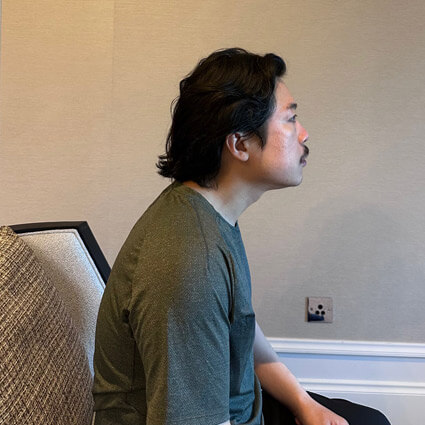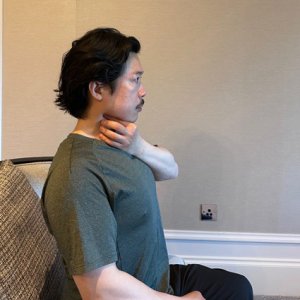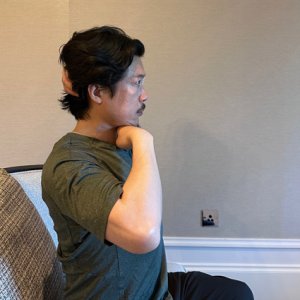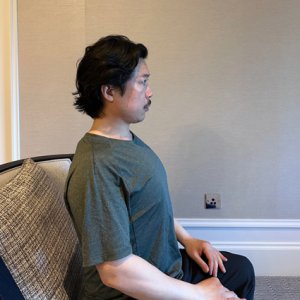In today’s digital age, where many of us spend prolonged periods in front of screens – whether on phones, tablets or computers – poor posture has become increasingly common. A typical result of this modern lifestyle is the gradual forward positioning of the head, which places undue strain on the neck and upper spine. Over time, this imbalance may lead to persistent neck tension, headaches, reduced mobility, shoulder discomfort, postural changes such as Dowager’s hump (kyphosis), disc irritation, and even lower back issues.
While these problems are widespread, the encouraging news is that with understanding, self-awareness and gentle therapeutic approaches, it is entirely possible to release neck tension, improve posture, and support long-term spinal health.
Why the Neck Struggles to Maintain Alignment
 Structurally, the neck is at a disadvantage when it comes to maintaining healthy alignment. It is influenced by several strong external forces that tend to pull it out of balance, while comparatively few internal stabilising forces work to hold the head in an ideal position.
Structurally, the neck is at a disadvantage when it comes to maintaining healthy alignment. It is influenced by several strong external forces that tend to pull it out of balance, while comparatively few internal stabilising forces work to hold the head in an ideal position.
The neck’s upright posture is primarily supported by muscles at the back of the spine and those running from the breastbone to the base of the skull, notably the sternocleidomastoids. These muscles are designed to support the head while allowing the front of the neck to remain free for essential functions like breathing, speaking and swallowing.
However, even a slight forward shift of the head from its natural alignment can create a cascade of dysfunction – the muscles at the back of the neck tighten, the front slackens, the chest collapses, and the shoulders round forward as the shoulder blades drift away from the spine.
Biomechanically, this is significant. For every 2.5 cm (1 inch) that the head moves forward from neutral, the effective weight placed on the cervical spine increases by approximately 4.5 to 5.5 kg (10-12 lbs). This added load results in cumulative strain on the neck’s delicate structures, including discs, ligaments, and deep postural muscles. Over time, the fatigue and stress this creates may not be noticed until pain and dysfunction have already developed.
Why Common Postural “Corrections” Can Backfire
Attempts to correct posture can often make things worse. Many people attempt to “stand up straight” by pulling their shoulders and heads back forcefully. This may lead to overuse of the upper back muscles, particularly the rhomboids, and increased compression at the base of the neck. Others may repeatedly tuck their chins in to align the head, which tends to flatten the natural cervical curve and restrict mobility. These external corrections are often based on how posture should look rather than how it should feel.
True postural improvement begins from within by restoring a sense of balance, internal awareness, and sensitivity to the body’s centre.
The Role of the Hyoid Bone in Postural Balance
 A commonly overlooked posture structure is the hyoid bone, a small, free-floating bone located just below the jaw. The hyoid links the throat, jaw, chest, and upper abdomen within a network of fine muscles and its position significantly influences both breathing and head alignment.
A commonly overlooked posture structure is the hyoid bone, a small, free-floating bone located just below the jaw. The hyoid links the throat, jaw, chest, and upper abdomen within a network of fine muscles and its position significantly influences both breathing and head alignment.
When we swallow, the hyoid lifts, gently stimulating the digestive tract and subtly activating the lower abdominal muscles. This natural motion offers a clue to how posture and internal muscle tone are deeply connected. It’s not uncommon to feel your lower belly draw in slightly when you swallow, a sign of the body’s innate integrative movement.
When the hyoid is balanced, it signals the upper neck and spine to release tension. A simple way to encourage this is to visualise the top of the throat “smiling” softly backwards and upwards, spreading from ear to ear. This subtle visual cue can gently realign the head and neck without force or rigidity.
Rather than forcing the chin back or straining to lift the chest, this internal “smile” helps dissolve unnecessary tension and restore fluid, natural alignment. It acts as a vital starting point in restoring postural balance, reconnecting the body to its internal centre and allowing the deeper stabilising muscles to engage without resistance or rigidity.
Strengthening the Deep Muscles of the Neck
Letting go of tension is only part of the solution. To maintain healthy posture, it’s also essential to build strength in the deep stabilising muscles of the neck, particularly the Longus capitis and Longus colli, located at the front of the cervical spine.
These muscles can be activated through slow, mindful movement. One simple technique is to lie on your back and gently lengthen through the crown of the head to engage the deep neck flexors, which help elongate and stabilise the spine.
Another effective method is to place one hand under the chin and gently press the chin isometrically downward into the hand, without creating visible movement. This encourages activation of the deep flexors while facilitating a gentle extension at the base of the skull. Focus on maintaining a lift through the back of the head while keeping a connected, grounded awareness through the diaphragm and lower rib cage. This integrative alignment supports the entire axial skeleton, not just the neck, reinforcing postural strength throughout the whole body.
Similarly, when standing, you can imagine a string lifting from the crown of your head to promote vertical alignment—without compressing the neck or shoulders. However, these exercises are most effective once tension at the base of the skull has been released, often beginning with the realignment of the hyoid bone, which influences head and neck balance.



Supporting Postural Realignment with Movement and Chiropractic Care
Gentle, intentional movement is a powerful way to reinforce healthy posture and restore balance within the musculoskeletal system. Specific standing postures help to lengthen the spine, reduce asymmetry, and reconnect the body to its natural axis. Guided backbends can strengthen the chest and neck; twists refine spinal alignment, and forward bends help release accumulated tension from prolonged slouching or screen use.
The effectiveness of these movements lies not only in the shapes we make but also in how we move into them. For example, in backbends, rather than tipping the head backwards and collapsing into the lower back, we gently slide the top of the throat back and lift through the heart. In twists, maintaining upward length through the crown of the head allows for integrated, spiral motion rather than forced rotation.
Movement therapy’s benefits are further enhanced when combined with instrument-based chiropractic adjustments. These gentle, targeted adjustments help restore normal spinal biomechanics, reduce joint restriction, and improve the body’s capacity for smooth, coordinated movement. By improving joint function, chiropractic care creates a more stable foundation for neuromuscular retraining, allowing the body to relearn healthy movement patterns more efficiently.
Subtle internal cues, particularly those centred around the hyoid, guide these changes in a way that feels sustainable. When spinal alignment is supported both structurally and through movement, the result is improved posture, a deeper sense of connection, ease, and long-term resilience.
Final Thoughts
As screen use and poor exercise habits continue to shape our modern lives, reconnecting with the body’s natural intelligence is more important than ever. At our holistic chiropractic clinic, we help patients restore balance through a combination of gentle adjustments, mindful movement, breath work, and subtle awareness. Our approach empowers you to feel more at ease in your body, not just on the treatment table but in everyday life.
*Disclaimer: The information provided in this article is for general educational purposes only and is not a substitute for professional medical advice, diagnosis, or treatment. While we aim to share helpful insights and tips, any actions you take based on this content are done at your own risk. Always consult with a qualified healthcare professional before beginning any new health practice or managing an existing condition. Your wellbeing is best supported under personalised, professional guidance.
